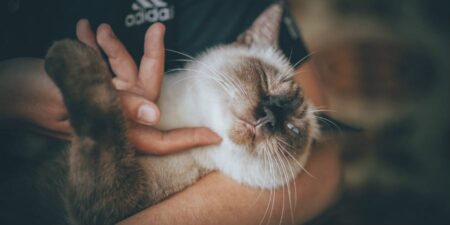Why do dogs and cats fight? This age-old question has puzzled pet owners for generations. The answer lies in their inherent differences and natural instincts.
Dogs and cats are different species with distinct behaviors and communication styles. Dogs, as pack animals, tend to be social and cooperative, while cats, solitary hunters by nature, value their independence.
Misunderstandings can occur when they misinterpret each other’s signals, leading to conflict.
Additionally, competition for resources like food or attention can also trigger fights.
But fear not, cats and dogs can, indeed, peacefully coexist — with proper socialization and training.
How Do Cats and Dogs Fight?

Dogs and cats are very different species. There are some similarities between the two in the wild, as both species are quite antagonistic. However, we don’t see the level of aggression in socialized animals.
When it comes to first impressions, dogs and cats sometimes misunderstand the signals put out by the other one. For example, when a dog wags its tail, it’s a sign that he is happy and playful. When a cat flicks his tail back and forth, it usually means your kitty is downright angry.
What a dog might intend to be a friendly gesture can be easily mistaken by the cat as aggression. For example, the dog might want to play, but the cat sees this as an intrusion on his space and flees the scene. The dog, who loves to chase smaller animals instinctively, will go after the kitty, not realizing that cats do not like to be chased.
A Brief History of Cats — How We Domesticated Cats (Video)
Dogs aren’t always the aggressors, though. It’s common for cats to stand up to dogs by arching their backs, hissing, or even swiping at the dog with his paw, claws fully extended. When confronted by this behavior, some dogs will respond by becoming afraid of cats in general.
There might be trouble if the dog is raised in an environment that encourages chasing and harming cats. This type of behavior and environment is not healthy for anyone. These domesticated animals are quite capable of living harmoniously, and their aggression should not be encouraged.
Similarities In Instinctual Behaviors
When in the wild, both animals are pack animals. They will live in an environment where there is an alpha animal who is usually the leader of the pack, so to speak. The rest of the pack will acquiesce to the alpha. Other pack members, usually the females, will do the hunting and bring food back for the rest of the pack.
Both species are equally as antagonistic when in the wild. Neither species is known to back down from a fight. They will similarly defend their pack, their young, and their food.
These behaviors are still very true of the wild relatives of today’s domesticated cats and dogs. Watch any animal documentary, and you can see the aggressive similarities between members of a pack of wolves. Likewise, that aggression is clear within a pride of lions.
Dogs have been domesticated for a longer period of time than cats have. They are also very easily trained. This gives the dogs the ability to control their behavior to some degree.
While cats have been domesticated for centuries and were even worshiped throughout time, they continue to be aloof by nature. They are also not easily trained. Because of this, cats might not be in control of their behavior to the same degree as the domesticated dog.
How Do Dogs and Cats Really Get Along?
Studies have shown that it’s normal for cats and dogs who live together to have moments of aggression. Cats used to their canine siblings will still hiss, spit, and swat at them on occasion. Dogs will still follow their instincts and chase their feline companions on occasion.
Even with these rare behaviors in households where dogs and cats coexist, it’s rare for these animals to truly harm the other. If the dog and cat encounter each other outside of their territories, for example, when a cat and a dog are unfamiliar with the go after each other, that is just simply the animals going back to their innate wild animal instincts.
Once socialized within the home environment, the dog and the cat can become best friends. If the dog gets a new toy, it’s not unheard of for him to want to share his new toy with his feline friend. Cats are unlikely to share in this behavior, meaning kitty won’t be in a rush to show the dog her new toy.
Once they know each other and consider each other siblings, do not be surprised to see them curl up together for a nap. There might still be occasions where the dog will chase the cat, but once they know each other, this behavior won’t be aggressive. It will all be fun for both of them. Don’t be surprised if, during this chase game, the cat turns the tables and chases the dog.
Sometimes, the cat will pick up some of the dog’s habits and become quite adept at the game of fetch. it’s always a good idea for each to have his or her own separate toys. While a cat’s favorite toy might be his fuzzy mousie, the dog won’t be likely to steal it from him. Likewise, with the dog’s rawhide chew toy, the cat won’t be likely to want to steal it.
Ultimately, once socialized, a dog and a cat can get along very well in the same household. However, since both animals are somewhat territorial, make sure that each has an area that is all theirs. You might want to get a cat tower that kitty can escape to when she wants to. A large dog bed or indoor doghouse can become the dog’s area. While a dog is not likely to try and climb the cat tree, don’t be surprised if the cat attempts to share the dog’s area with him. Realistically, it all depends on which one was there as a pet first as they will most likely become the alpha animal.
Living Under The Same Roof
You have started a new family, and you decide that you would like to have both dogs and cats in the household. While there are some situations where you can throw the two together immediately, it’s best to plan, and hope for the best but expect the worst.
Ultimately, if the animals are raised together, in a positive environment, they will be friends and, at worst, at least be tolerant of the other one. it’s important when choosing your new pets that you look for personalities that might be compatible. For example, a cat who is skittish and easily spooked might not adapt well to a family with a dog. Likewise, a dog that shows aggressive behaviors would most likely not be a good fit for a family with a cat.
Experts recommend that for a first-time mixed family adventure, the cat be less than a year old. The younger the animal, the easier it’s for them to adapt to new family members of the house pet variety. The same goes for the dog. it’s easier to bring up a kitten and a puppy together to achieve a life of harmony.
Since dogs can be trained better than cats, it’s important that you train your dog to control his or her natural instincts. Some actually recommend that the dog not be introduced to his new feline sibling until he has been through training. If this can be arranged, there is less likely to be incidents where one of the animals might accidentally get injured.
If possible, allow the animals to sniff each other’s space prior to their actual meeting. This will allow them to be accustomed to each other’s scent. While they should be allowed to occasionally venture into the other’s area, keeping their bedding and toys separate is best.
While both species can tend to be territorial, it’s more important to give the cat his own protected space where the dog isn’t allowed. Since cats are natural climbers, give them a place to climb. Having a cat tree where the kitty can safely observe the activities of the rest of the family serves as an excellent haven for him or her.
When it comes to mealtime, it’s highly recommended that the animals be fed on the same schedule. However, it’s important to keep their feeding areas separate. Cat food is not good for dogs, just as dog food is not good for cats. This way, they also do not think it’s fair game to go after each other’s food.
Train the dog to stay away from the litter box. Although many a dog has been known to snack on the contents, giving the kitty some privacy while doing his thing gives him another part of the house that provides a safe haven. Besides, dogs can contract intestinal parasites from this particular snacking habit.
Giving them separate playtime is also important. Taking the dog for a walk or out to the dog park gives him or her one on one time with their human as well as allows them to run off some of their pent-up energy. Similarly, a kitty probably wants some quiet time with his or her humans that is not intruded upon by the dog.
By raising the animals in a loving and positive environment, it’s possible to have a home where the cat and the dog don’t fight. Even in those situations where they might not exactly like each other, if you train them right and raise them together, you can ultimately have a peaceful relationship.
Why Do Cats and Dogs Fight? (Video)
"In ancient times cats were worshipped as gods; they have not forgotten this."
-- Terry Pratchett





